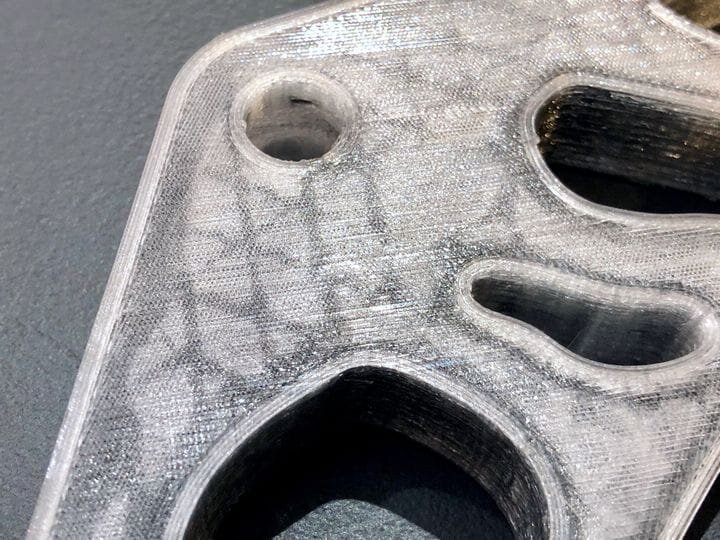![A 3D print with embedded continuous carbon fiber [Source: Fabbaloo]](https://fabbaloo.com/wp-content/uploads/2020/05/carbon-fiber-3d-print-1_img_5eb08d4985354.jpg)
This week’s question is about “filaments with long fibers”.
Fabbaloo reader May writes:
“Are you also selling filaments for 3D printing? I’m looking for a filament that is made of a polymeric matrix, reinforced by long and continuous fibers. If you do sell those, can you please send me back a list of those kinds of filaments?”
Thanks for the question, May. We try to answer good questions in a post so that everyone can see the answers and spread some knowledge around.
First of all, we don’t sell any filaments; we are a news source, however, and know a little bit about the topic.
Early 3D Printer Filaments
Until only a few years ago, most 3D printer filaments were made from a single material. You would commonly see filaments made from ABS, PLA and sometimes PETG.
Then things got a lot more complex as composite filaments and different chemical mixes became more common. I suspect this is because the early filament materials were generally not very good as they had not been designed for 3D printing, and were chemically composed many years earlier for different functions.
The filament makers of the day turned to the chemical companies for advice and partnerships. This was an important step because up until then the chemical companies had more or less ignored the 3D printing market entirely. But over time they’ve come to recognize that 3D printing is a market that will grow significantly over time and most of them are currently jostling for position in the market.
Composite Filaments
Composite filaments are an important category in the world of 3D printing filaments these days. The idea is to take a typical mono-material such as PETG, PLA or Nylon and mix it with other substances to create a kind of hybrid that has the best properties of both.
Early composite filaments were made from metal powder and co-polyesters. These heavy filaments were used to produce metal-like objects that contained significant ratios of metal and acted much like a fully metal object. Another early material was wood fiber, which produced objects that could be cut, sanded and painted exactly like wooden objects.
More recently there’s been a focus shift towards more engineering-style composite materials, which parallels the industry shift to professional applications. Professionals want materials with specific properties for the parts they are designing. This means added strength, increased heat or chemical resistance, etc.
Fiber Reinforced 3D Printer Materials
There’s growing interest in what’s known as fiber-reinforced filaments recently. These are typically nylons mixed with tiny segments of either carbon fiber or glass. The resulting prints are significantly stronger than just the nylon alone.
However, in the case of carbon fiber-reinforced material, it’s nowhere close to being as strong as what’s known as “continuous carbon fiber”. This is where the carbon fiber is literally in the form of a wire that is embedded along some axis of the 3D print. Such material is fantastically strong, perhaps the strongest thermoplastic objects that can be 3D printed.
Your question relates to whether there are 3D print materials with “long fibers”. The answer is “no”. There are only two choices for fiber-reinforcement.
Composite Filament Clogs
The first is what I described above: tiny segments of fibers mixed in with another binder. The reason for the tiny size of the fibers is that they must be small enough to pass through the rather small nozzle on the 3D printer’s hot end. If they are slightly larger they will tend to clump at the nozzle and create a clog. I’ve had this happen to me with a wood filament that had fibers a bit too long. I had to remove the nozzle and burn out the debris with a torch to repair things.
Continuous Carbon Fiber
The other option is to use continuous carbon fiber, and for this you will need a specialized 3D printer that includes a spooler to lay down actual continuous carbon fiber within a print. There are currently only a few devices that can accomplish this, including equipment from Anisoprint, Markforged, and most recently, Desktop Metal.
Each company provides their own materials for their equipment, so if you buy that device, you will use their material.

